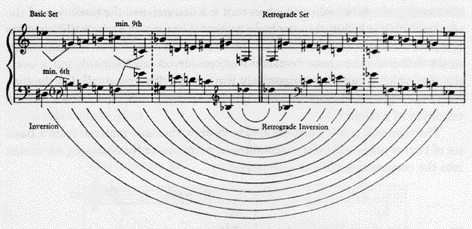Abstraction in Music

Arnold Schoenberg, example 4 from
Composition with Twelve
Tones (1) (1941),
in Schoenberg, Style and Idea: Selected Writings,
ed. Leonard Stein; ed. and trans. Leo Black
(Berkeley: University of
California Press, 1994).
1975 Belmont Music Publishers.
Just as the conventions of figurative painting were radically transformed by abstraction after the turn
of the century, so too were the fundamental forms of music by the
twelve-tone system of composition developed by Arnold Schoenberg.
By 1912, Schoenberg had liberated his music from the rules of traditional tonal harmony and was composing atonal music, using all twelve notes of the chromatic scale. He deliberately avoided any tonal center, fragmented the melodic lines to avoid
traditional-sounding melodies, and favored dissonant intervals. (It was around this time that Vasily Kandinsky was first captivated by Schoenberg' s music, and a long-lasting friendship and correspondence between the two began.)
Seeking a way of organizing and unifying the unlimited possibilities he had unleashed, in the early 1920s Schoenberg arrived at his twelve-tone system a method of composition with twelve tones related only to one another in which all the m
elodic and harmonic elements of a composition are derived from a basic arrangement of the twelve tones as ordered by the composer. A composition can be made from this arrangement (known as a tone row ) along with its variants, which are derived by invert
ing the intervals of the row, reversing the row, or doing both at once in retrograde inversion (see the illustration on the other side of this column). All twelve tones must be used before any of
them is repeated, but the twelve notes of the row may be presented in succession as a single melodic line, in counterpoint as two or more melodic lines, or combined vertically as chords or tone clusters.
In keeping with the systematic nature of this compositional approach, Schoenberg preferred the title constructor to composer. His method, which has been followed or adapted by many over the century, has provided composers with a surprising degr
ee of freedom within its orderly framework.
Abstraction in the Twentieth Century
Total Risk, Freedom, Discpline
The Pioneers
Between the Wars
Abstract Expressionism
Monochrome Painting
Minimal Sculpture
Post-Minimal Sculpture
The Museum of Non-Objective Painting
Abstraction in:
Photography
Theater
Architecture
Poetry
Film
Dance
